Exploring the Impact of Light Bulbs on Interior Design
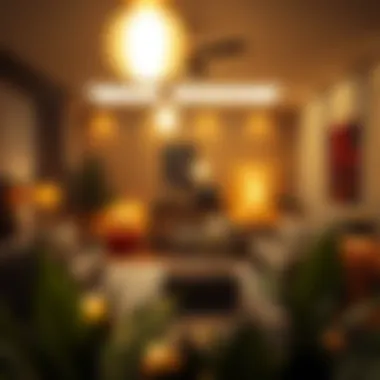
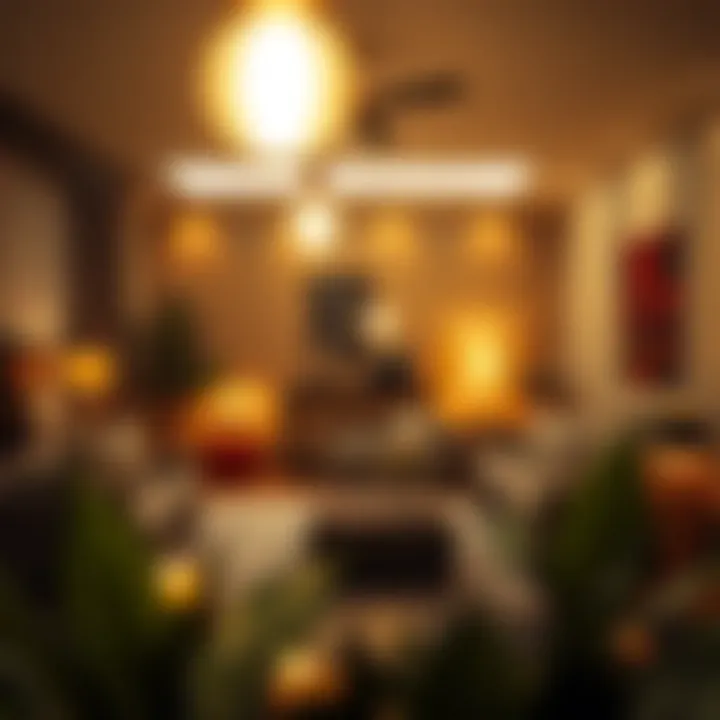
Intro
In any living space, light is more than just a necessity; it forms the very backbone of interior design. While the sun takes a hiatus each evening, the right choice of light bulbs can transform a room from stark and cold to inviting and cozy. The multifaceted role of multiple light bulbs goes beyond illumination—it encapsulates a seamless blend of aesthetics, functionality, and energy efficiency. Homeowners, interior designers, and decorating aficionados understand this well; creative lighting can elevate the everyday experience of a home.
Choosing multiple light sources isn't merely about brightness levels; it involves layering techniques that create depth and interest in an interior space. This aspect, along with recent trends in furniture and decor, brings forth the idea that lighting is a critical design element. In exploring this concept, we will delve into the current design trends and material innovations that reflect the evolving tastes in modern interiors, digging deeper into how varied light sources can enhance the personality of a space while maximizing efficiency.
Design Trends
When it comes to interior spaces, current trends are all about embracing diversity—both in design styles and lighting choices. Layering various light bulbs helps in crafting a multi-dimensional look that aligns beautifully with the contemporary aesthetic and even vintage inspirations.
Contemporary Styles
The modern home often features an eclectic mix of textures, colors, and functional designs. Lighting plays a pivotal role in setting the overall tone. Here are some popular contemporary styles:
- Minimalism: Less really can be more. A sleek, understated approach often employs pendant lights and recessed lighting, focusing on functionality without compromising elegance.
- Industrial Chic: Think of exposed bulbs in warehouse-style settings—concrete walls mingling with warm, glowing filaments. This aesthetic celebrates the raw truth of material and form.
- Scandinavian Design: Characterized by bright living spaces filled with natural light, this style often incorporates soft, diffused lighting, with multiple sources blended for harmonious visual balance.
Vintage Inspirations
Venturing further back in design aesthetics offers another layer to consider. Vintage and retro lighting can inject personality and warmth into a modern space:
- Art Deco: The bold geometric shapes and intricate details of Art Deco fixtures draw the eye and can elevate subtler decor themes.
- Mid-Century Modern: Classic pieces with organic shapes and vibrant colors hark back to the design movements of the 1950s and 60s, offering nostalgic charm.
- Rustic Farmhouse: Incorporating classic Edison bulbs in fixtures made from reclaimed wood brings together the essence of rugged simplicity with modern convenience.
Lighting is not merely an accessory. It's an essential component that elevates the essence of any space.
The interplay of different styles can allow for personalized narratives within a home. Homeowners often find that mixing and matching types of lights—sconces, wall-mounted fixtures, pendants, and LED strips—can create not just a functional space but a storytelling environment.
In scrutinizing these styles, we see clearly that lighting isn’t just a functional need; it represents an opportunity for expression—a chance to showcase individual tastes through the ambience created. This awareness is vital for anyone involved in interior design or just seeking to enhance their living environment.
The Evolution of Lighting in Interior Design
Lighting has always played a role greater than mere visibility. It sets the tone, adds depth, and can transform an ordinary room into something reminiscent of a cinematic scene. Tracing the evolution of lighting within interior design unveils not just a timeline of technological advancements but also a reflection of cultural shifts, aesthetic preferences, and environmental considerations. In modern interiors, multiple light bulbs serve as a fundamental element, revealing their significance in enhancing both the functionality and aesthetics of a space.
Historical Perspectives on Lighting
Historically, lighting evolved from the natural sunlight that streamed through windows to candles, oil lamps, and eventually to electric sources. Each of these shifts marked notable changes in how spaces were perceived and how people interacted within them. For instance, the advent of candles allowed for longer evenings spent indoors, while oil lamps provided a brighter, steadier glow, making rooms feel cozier during colder months. Lighting, in past societies, was more than just illumination; it was a status symbol, often showcased through ornate candle holders or opulent chandeliers. The materials used, such as fine glass and metals, spoke volumes about the wealth of the homeowner.
Emergence of Electric Lighting
The introduction of electric lighting in the late 19th century revolutionized home design. No longer dependent on the setting sun, people could now embrace longer days and vibrant night life. Practical considerations arose, such as bulb placement and fixture design, which began to shape the way rooms were constructed. Electric light offered unprecedented control over brightness and color, enabling designers to play with shadows and highlights that influenced a room's atmosphere.
Electric lighting also sparked the trend of layering various light sources to enhance both function and aesthetic. In modern interiors, these principles continue to thrive, with designs often incorporating different types of bulbs to achieve ambient, task, and accent lighting, showcasing the versatility that electric light brings to the table.
Transition to LED Technology
Today, we find ourselves amid a digital revolution in the realm of lighting, with LED technology leading the charge. These light bulbs are often celebrated for their energy efficiency and longevity, shifting the conversation toward sustainability in interior design. LEDs offer a remarkable range of color temperatures and brightness levels while significantly reducing energy consumption compared to incandescent and fluorescent bulbs.
As homeowners and designers prioritize eco-friendly practices, understanding the benefits of LED technology has become increasingly essential. Designers can now explore creative applications, enhancing not just the look of a space but also its energy footprint. The modern ethos leans toward thoughtful choices in lighting, with many opting for LED solutions that marry environmental responsibility with aesthetic appeal.
In sum, as we navigate through history, it becomes clear that the evolution of lighting is deeply intertwined with our changing values and technological progress. The dialogue surrounding multiple light bulbs in interiors is not merely an exploration of functionality; it speaks volumes about our aspirations for beauty, comfort, and sustainability in our living spaces.
“Lighting is not just about illumination; it’s about creating experiences.”
Understanding Different Light Bulb Types
Inning accordance with modern interior design, light bulb selection is a key component that can make or break the ambiance of any space. The variety of light bulb types available each bring their unique characteristics, making it essential to understand their particularities. Not only do different bulbs serve their own functions, but they also contribute to the overall aesthetic and energy consumption of a home. As folks increasingly look for efficient and stylish lighting solutions, navigating the realm of light bulbs becomes imperative. It’ll help homeowners, decorators, and designers choose the right type that aligns with both their practical needs and visual aspirations.
Incandescent Bulbs
Incandescent bulbs are often what people think of as the classic light source. They work through a simple mechanism: an electric current flows through a thin filament, warming it until it glows. Despite their charm, they are infamous for being energy-hungry. The warmth of their light is often compared to a cozy summer day, perfect for making a place feel welcoming. However, their brevity is a downside, as they tend to burn out quickly.
The positive side? They are dimmable and come in numerous shapes and sizes, allowing for ample creativity in design. Though they are being phased out in many areas due to stricter energy regulations, their unique glow and authenticity can still be enjoyed in certain settings—especially where warm light is prioritized.
Fluorescent Bulbs
Fluorescent bulbs offer a different, more utilitarian approach to lighting. They operate using a gas-filled tube where electricity excites the gas, producing ultraviolet light which then illuminates the phosphor coating inside the bulb. They are generally far more energy efficient compared to incandescents and can last several times longer.
However, the light produced has often been criticized for its harshness, which can create a sterile or clinical feel, making them a less popular choice for living spaces. That said, they are hugely beneficial in work areas, such as garages or workshops, where practical, bright light is crucial. They serve the purpose but might not always be the best fit aesthetically.
LED Bulbs
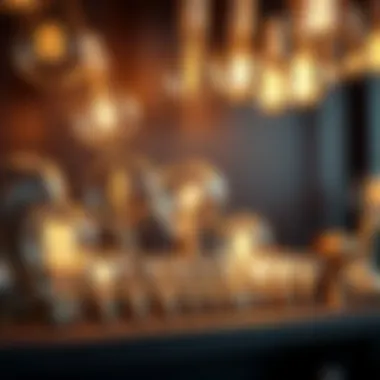
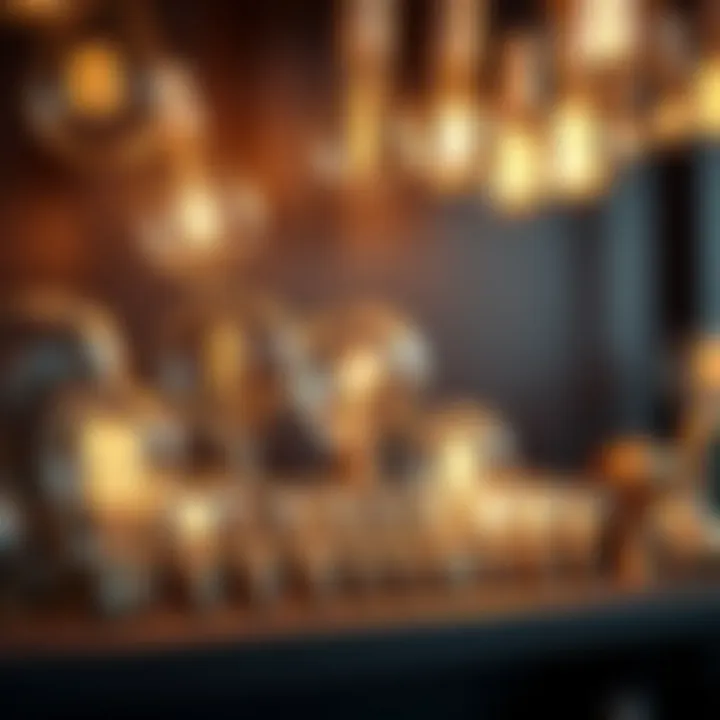
When talking about efficiency and versatility, LED bulbs take the cake. They are known for using a fraction of the energy compared to incandescent or fluorescent bulbs. LEDs emit light when an electric current passes through a semiconductor, making them cooler and safer to touch. This mechanism allows them to be designed into all sorts of shapes and sizes, seamlessly adapting to various design preferences.
One notable aspect of LEDs is their adaptability. Many modern models come equipped with a variety of color temperatures and brightness levels which can easily be adjusted to set moods or highlight certain areas. This flexibility makes them the go-to bulb for modern homeowners eager to curate the right atmosphere in their spaces. Although initially more expensive, their trajectory in energy savings and lifespan yields substantial cost benefits over time.
Halogen Bulbs
A subset of incandescent lighting, halogen bulbs differ primarily in that they contain a small amount of gas that allows for a tighter filament. This leads to a brighter light output. They offer an enticing clarity that can invigorate any space. Their whiter light closely resembles natural daylight, appealing for those looking to enhance the vibrancy of their environments.
Yet, they can be found wanting in energy efficiency when compared to LEDs. They generate a significant amount of heat, which can be a safety concern and can also affect energy costs if left on for extended periods. Halogen bulbs might serve specific purposes, primarily where high-intensity illumination is essential, such as in track lighting or in display cases.
"Choosing the right light bulb is not just a matter of brightness; it’s about understanding how it aligns with functionality and design aesthetics."
In summary, each light bulb type carries distinct advantages and disadvantages. The choice of lighting plays a fundamental role in creating inviting interiors, ensuring that spaces are not only functional but also comfortable and reflective of the homeowner's style. Understanding the properties of each type can empower homeowners and designers alike to curate inviting atmospheres that meet their specific needs.
The Science of Light and Color
Understanding the science of light and color is crucial in enhancing modern interiors. Light doesn't merely illuminate; it enriches spaces, shapes perceptions, and influences emotions. Multiple light sources can dramatically alter the atmosphere of a room, making knowledge of color temperature and its effects vital for homeowners and designers alike.
Light plays a vital role in defining how we perceive colors. Different light sources emit various temperatures, measured in Kelvins (K), which profoundly impacts the visual experience. Choosing the right light can either magnify the serene hues of a space or make it feel cold and unwelcoming. This is pivotal when designing spaces that offer function and comfort.
Color Temperature and Its Impact
Color temperature refers to the warmth or coolness of light and directly affects how spaces are perceived. Warmer lights (2700K to 3000K), such as those emitted by incandescent bulbs, create a cozy, inviting environment, excellent for relaxing areas like living rooms and bedrooms. On the other hand, cooler lights (4000K to 6500K) resemble daylight, enhancing focus and energy, making them suitable for task-oriented spaces like kitchens or home offices.
- Warm Light:
- Cool Light:
- Encourages relaxation.
- Ideal for intimate settings.
- Complements earthy colors.
- Boosts alertness and concentration.
- Works well in workspaces.
- Enhances vibrant colors.
Depending on the activity, the choice of light temperature can seem as impactful as selecting the right furniture. As a rule of thumb, balance is key; layering different color temperatures can add depth and dynamism to a room.
The Influence of Light on Mood
The interplay between light and mood is a relationship that often goes unnoticed. Various studies indicate that light can significantly affect psychological states - think about how bright and soft light changes a room's energy. A dimly lit space may evoke a sense of calm and intimacy, perfect for winding down, while bright, white lighting can enhance productivity and stimulate activity.
"Lighting impacts not just how you see a room but how you feel within it."
- Natural Light:
- Artificial Light:
- Often enhances a positive mood.
- Applied strategically within interiors to increase energy levels.
- Using colored light can set a specific emotional tone, impacting social interactions.
- Dimmer switches can provide flexibility, adjusting lighting based on the time of day or the mood desired.
Addressing light as a design element provides opportunities to cultivate spaces that resonate with personal feelings and function. As you design with light in mind, remember that the nuances of color can be just as important as the fixtures themselves. Choosing to combine various types of light sources can harness their unique qualities and ultimately transform spaces from ordinary to extraordinary.
Designing with Multiple Light Bulbs
Creating the right ambiance in a room is invaluable in modern interiors. Using multiple light bulbs allows for versatility in design, enhancing both the look and the function of a space. The significance of mastering this skill cannot be overstated, as it influences everything from daily activities to mood. Designers and homeowners, alike, benefit from understanding how light can transform and elevate living spaces.
Layering Light Sources
Ambient Lighting
Ambient lighting serves as the foundation of any lighting design. This type of lighting provides a uniform illumination across a room, ensuring that every corner is bathed in light without shadows. It’s often achieved through ceiling fixtures, chandeliers, or wall-mounted lights. One key characteristic of ambient lighting is its ability to create a sense of security—its gentle glow fills a space and makes it feel inviting. This is what makes it a popular choice for living rooms, bedrooms, and areas where relaxation is key.
A unique feature of ambient lighting is its capacity for flexibility; it can easily adapt to different styles, whether your home is modern, traditional or somewhere in between. However, it may have its downsides. Relying solely on ambient lighting can lead to spaces that lack definition or depth. Therefore, incorporating additional layers is often advantageous.
Task Lighting
As the name suggests, task lighting is specifically aimed at helping with activities that require focus, such as reading, cooking, or working. This type of illumination is often more direct and concentrated, provided by desk lamps, under-cabinet task lights, or even spotlights. The defining feature of task lighting is its directed nature, which makes it a beneficial choice when precision is necessary. Homeowners can enjoy increased productivity thanks to the ability to tailor the lighting to their specific needs.
In terms of unique advantages, task lighting often features adjustable options—brightness can be modified depending on the time of day or the task at hand, creating optimal conditions for work or leisure. Yet, it's important to recognize potential drawbacks; if implemented poorly, it can create harsh contrasts, leading to eye strain or discomfort.
Accent Lighting
Accent lighting takes the spotlight—literally. This type is designed to highlight particular areas or objects within a room, such as artwork, architectural features, or even plants. Using spotlights, track lights, or well-placed wall sconces can really bring a space to life. A key characteristic of accent lighting is its ability to add drama and focus. This makes it an appealing choice for those wanting to showcase individual design elements.
The unique advantage of accent lighting is its transformative effect. It can drastically change the feel of a space, making it feel more luxurious or inviting. However, relying heavily on accent lighting could lead to a disjointed atmosphere if not balanced with ambient or task options.
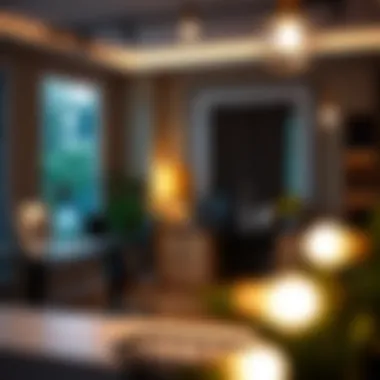

Creating Visual Interest
Layering light effectively can create captivating visual experiences. By combining different types, homeowners can explore dimensions and moods within their rooms—creating a warm, cozy vibe one moment and a vibrant active space the next. Adjusting the brightly lit and softly illuminated areas of a room can invite variety into your life.
"Lighting is both functional and emotional; it has a profound impact on how we experience spaces."
Using light as a design tool allows one to play with textures and colors. For instance, warmer tones can create intimacy, especially in dining areas or cafes. In contrast, cooler tones can promote vitality and alertness, great for workspaces.
Focal Points in Interior Spaces
Strategically highlighting focal points can lead to an enriched viewing experience. This is where the synergy of different light sources becomes crucial. Perhaps there’s a beautifully framed painting or a unique architectural detail that deserves attention. Employing a blend of ambient and accent lighting around those elements pulls the eye and makes the entire space more engaging.
In summary, being mindful about how you design with multiple light bulbs offers a multitude of pathways to refine, elevate, and personalize your living spaces. The interplay of the different types of light—ambient, task, and accent—combined with careful consideration of how they complement one another, opens doors to unprecedented beauty in home design.
Innovative Applications of Lighting
In the realm of interior design, the innovative applications of lighting play a pivotal role in shaping not just aesthetics but also functionality and ambient experience. With the constant evolution of technology and design philosophy, lighting has transformed from mere utility into a dynamic tool for expression. This section delves into how novel lighting solutions can enhance our spaces, creating atmospheres that resonate with personal style and enhance day-to-day tasks.
Smart Lighting Solutions
The advent of smart lighting solutions has undoubtedly altered the way we engage with illumination in our living spaces. These advanced systems offer more than just brightness; they provide control and customization at our fingertips.
For homeowners, smart lighting can be programmed to adjust based on the time of day, creating cozy evenings through warmer hues and brightening up mornings with cooler, energizing effects. Notably, voice-activated systems like Philips Hue or LIFX integrate seamlessly with existing smart home ecosystems. Their ability to change colors and dim lights at will adds a layer of convenience that changes how spaces feel.
Here are a few benefits that smart lighting brings:
- Energy Efficiency: Smart bulbs, typically LED, use significantly less energy compared to traditional options. This translates into lower utility bills and reduced carbon footprints.
- Scenario Setup: Whether it’s a movie night or a dinner party, you can easily set up the lighting to suit the occasion, enhancing the overall experience.
- Enhanced Security: Automated lighting schedules can deter potential intruders, providing a semblance of occupancy even when you’re away.
However, while these solutions offer numerous advantages, one must consider the compatibility of bulbs with existing fixtures and the possibly steep learning curve associated with setup.
"Smart lighting is not just a trend; it's a glimpse into the future of how we live and interact with our homes."
Decorative Light Fixtures
While function is paramount, the aesthetic appeal can’t be overlooked when it comes to lighting. Decorative light fixtures serve as more than simple sources of light; they are often the centerpiece of a room, shaping the mood and atmosphere of a space.
From chandeliers that exude grandeur in dining areas to minimalist fixtures in a contemporary study, the choices are vast. Decorative lights can tie together color schemes and styles throughout your home, turning everyday environments into artistic expressions.
Here are some types of decorative light fixtures that stand out:
- Pendant Lights: These can be hung at varying heights, making them versatile for different spaces. They can infuse personality above kitchen islands or dining tables.
- Wall Sconces: Often overlooked, these fixtures can dramatically change the ambiance of an area, especially when used in hallways or beside mirrors to enhance light quality.
- Table and Floor Lamps: Providing flexibility to create focal points, they can also offer a warm glow in corners that tend to be dark.
Incorporating decorative fixtures requires some thought, but the result can make a significant difference. They can highlight architectural features, add layers of illumination, and even serve as a conversation starter.
Energy Efficiency in Lighting Choices
As the world becomes more aware of environmental issues and the impacts of energy consumption, the importance of energy efficiency in lighting choices cannot be overstated. Homeowners and designers alike are beginning to recognize the dual role that lighting plays: it beautifies spaces while also influencing energy bills and sustainability. Choosing the right light bulbs can significantly reduce energy usage and encourage greener practices in our homes. In this section, we examine the nuances of energy efficiency, providing a deeper understanding of its various benefits and considerations.
Comparative Analysis of Energy Consumption
When evaluating energy efficiency, one must consider the consumption levels of various light bulb types. Incandescent bulbs, once the mainstay of residential lighting, consume significantly more energy than their modern counterparts. They convert most of the energy to heat rather than light, making them less efficient. For example, a standard 60-watt incandescent bulb may provide about 800 lumens, whereas an LED bulb only requires about 8 to 12 watts to produce the same amount of light. Not only do these LEDs consume less energy, but they also have a far longer lifespan.
In practical terms:
- Incandescent Bulb: 60 watts, ~1000 hours lifespan
- LED Bulb: 10 watts, ~25,000 hours lifespan
- Compact Fluorescent Bulb (CFL): 15 watts, ~10,000 hours lifespan
The clear disparity in both energy consumption and longevity showcases why energy efficiency is now a crucial consideration in lighting design. A household switching from incandescents to LEDs could see up to a 75% reduction in lighting energy usage. This not only lessens the load on personal utility bills but also contributes to a decrease in demand on power plants, which can lead to reduced greenhouse gas emissions.
"Energy efficiency in lighting isn't just a trend; it’s a necessary step towards sustainability and cost savings."
Long-Term Cost Benefits
The financial benefits of investing in energy-efficient lighting options extend beyond mere savings on electricity bills. While the upfront cost of LED bulbs might be higher than that of incandescent bulbs, the total lifetime cost balance changes significantly when one considers longevity and energy usage. For instance, an LED bulb might initially cost $8, whereas an incandescent might be around $1. However, if a homeowner opts for the LED, the long-term savings will often outweigh the initial costs.
In a scenario where a household replaces ten incandescents with LEDs:
- Annual Cost for Incandescent Bulbs:
- Annual Cost for LED Bulbs:
- Energy Cost: $120 per year
- Bulb Replacement (lasting 1 year): $10
- Total: $130

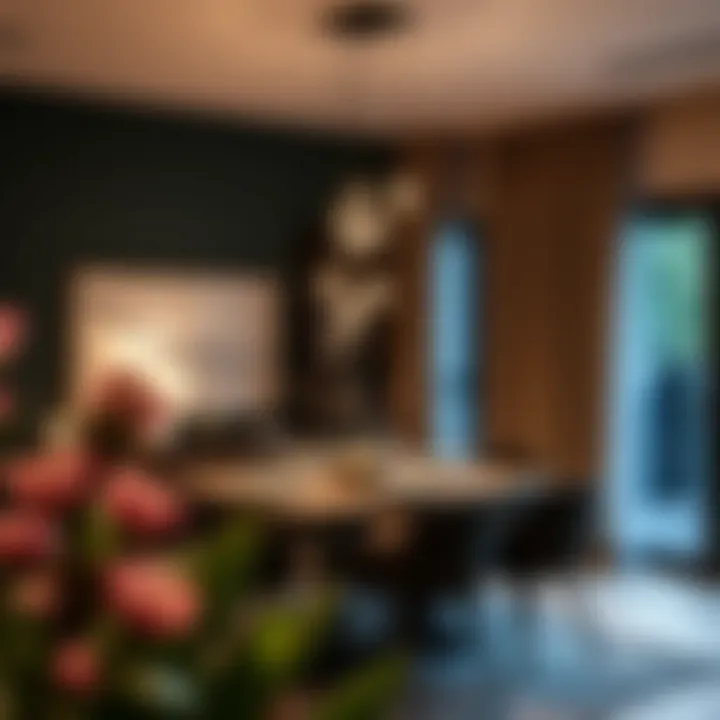
- Energy Cost: $25 per year
- Bulb Replacement (lasting 25 years): $4
- Total: $29
Thus, the total savings over 25 years can amount to over $2,500 when you factor in replacements and energy costs!
Ultimately, adopting energy-efficient lighting technologies leads to significant savings that can be redirected toward other areas of home improvement or leisure. It’s an investment that not only pays off in the pocketbook but also fosters responsible energy consumption, a practice that should resonate with today’s conscientious consumers.
Challenges in Lighting Design
The impact of proper lighting design is undeniable when it comes to modern interiors. Yet, this area is fraught with challenges that can complicate the execution of a well-thought-out lighting plan. As homeowners and designers navigate through various styles and technologies, understanding the potential pitfalls is crucial in achieving an ideal balance between aesthetics and functionality. Each of the challenges faced can offer valuable insights that lead to improved design strategies and better choices in lighting products.
Balancing Aesthetics and Functionality
Finding the sweet spot where aesthetics and functionality intersect can be a tightrope walk in lighting design. On one hand, you want to create a visually striking environment that captures attention and enhances the overall decor. On the other, the light must serve its intended purpose—providing visibility for tasks such as reading, cooking, or working. This tension often leads to what you can call the "form vs. function" debate.
Consider a beautifully designed pendant light that, while stunning, may not cast sufficient light for a task-oriented space such as a kitchen. It's essential to assess whether a light fixture will actually meet the practical requirements before letting its appearance take center stage. In a nutshell, good lighting should not only dazzle the eyes but also do its core job effectively.
Adapting to Space Limitations
Space is always a limiting factor in design, often leading to compromises in lighting decisions. Small spaces present unique issues; they require careful planning to maximize utility without overwhelming the area. The limitations can stem not only from physical dimensions but also from the architecture of a space.
Integrated lighting, such as recessed lights or adjustable track lighting, can help in optimizing illumination without hampering the aesthetics of a room. Moreover, the use of mirrors and lighter color palettes can help reflect and disperse light effectively, creating an illusion of space. This adaptive approach to lighting can significantly expand the sense of openness without physically altering the area.
Great lighting can make a limited space feel larger if designed thoughtfully.
As you delve deeper into challenges, it becomes evident that a holistic approach to lighting design is key. Homeowners and designers must collaborate and communicate effectively to navigate these challenges, prioritizing both beautiful and functional solutions for their unique interiors.
Future Trends in Lighting Design
The role of lighting in modern interiors has evolved beyond mere functionality. It now embodies creativity and innovation, blending aesthetics with technology. Future trends in lighting design are pivotal for homeowners, interior designers, and decorators alike. They not only enhance the beauty of spaces but also promote energy efficiency and sustainability. As we move forward, understanding these trends can empower households and professionals to make informed decisions that enhance interior environments for comfort and efficiency.
Emerging Technologies in Illumination
Emerging technologies in illumination are changing how we perceive and utilize light in our homes and workplaces. Smart lighting systems are at the forefront of this transformation. With options like Philips Hue, users can easily control lighting via smartphone applications or voice commands. This offers convenience and the ability to adjust ambiance with a click or a phrase, making lighting both functional and intuitive.
Another fascinating advancement is the advent of tunable white light. These systems allow users to adjust the color temperature to match the natural light outside, promoting health and well-being. For instance, achieving warmer hues in the evening can encourage relaxation, while cooler tones can invigorate you during the day, mimicking daylight cycles.
Additionally, OLED (Organic Light Emitting Diodes) is generating buzz for its unique ability to deliver soft, diffused lighting. This technology is not only energy-efficient but also promises a gorgeous, sleek design that can be incorporated into furniture or walls seamlessly.
Sustainable Practices in Lighting
Sustainability is no longer just a trend; it has become essential. As homeowners and industry professionals seek ways to minimize their environmental footprint, lighting design is no exception. Implementing sustainable practices in lighting is gaining traction, focusing on energy-efficient bulbs and renewable energy sources.
Many homes are now fitted with solar-powered exterior lights, which harness the sun’s energy. This approach not only saves on electricity bills but also reduces dependence on traditional power sources. Moreover, by opting for LED bulbs, which last significantly longer than incandescent options, households can further decrease waste and conserve energy.
"By prioritizing sustainability in lighting design, we are investing in the planet and our future."
Incorporating dimmers and motion sensors also play a crucial role in responsible lighting use. Dimmers allow for adjusting brightness according to need, significantly reducing energy consumption. Meanwhile, motion sensors ensure that lights are only on when needed, thus promoting a culture of efficiency.
The future of lighting design is promising, filled with remarkable innovations and a steadfast commitment to sustainable practices. By keeping a pulse on these trends, individuals can transform their living spaces into holistic environments that marry functionality with artistry.
Final Thoughts on Multiple Light Bulbs
The intricate relationship between multiple light bulbs and modern interiors can't be overstated. Not only do they serve as sources of illumination, but they also add layers of depth and character to our living spaces. The choices we make concerning lighting can dramatically influence the ambiance, functionality, and aesthetics of a room. In an age where energy efficiency often goes hand in hand with style, selecting the right mix of bulbs and fixtures is more critical than ever.
Each type of light bulb offers unique advantages and reflects individual tastes—be it the warmth of incandescent, the efficiency of LEDs, or the versatility of smart lighting solutions. Light bulbs not only set the mood but also shape our interactions with our environment.
Moreover, as we juggle between aesthetics and sustainability, it’s essential to consider these factors in our lighting decisions. The balance of form and function becomes paramount in creating inviting and practical spaces.
"Lighting is essentially a language, articulating the essence of an interior more than any other element."
Summarizing Key Insights
In summary, multiple light bulbs are not just tools for illumination; they are vital components of interior design that can transform spaces in various ways:
- Aesthetic Enhancement: Different bulbs create varying atmospheres—from cozy and intimate to bright and lively, depending on their color temperature and brightness.
- Functional Versatility: Task lighting, ambient illumination, and accent lighting can be layered to address specific needs in any given space, enhancing usability without sacrificing style.
- Energy Efficiency: With the availability of efficient bulbs like LEDs, users can achieve significant savings on energy bills and reduce their carbon footprint.
- Technological Integration: Smart lighting systems offer the ability to control and customize light settings from anywhere, paving the way for convenience and modern living.
Taking these insights into account can guide homeowners and designers alike in making informed decisions that elevate the quality of life in their environments.
Encouraging Thoughtful Choices
Lighting decisions should be driven by both function and aesthetics, reflecting the user’s personal style and the specific needs of the space. Here are some considerations for making thoughtful choices when selecting multiple light bulbs:
- Evaluate Your Space: Assess each room’s purpose—consider whether you need a calming ambiance for relaxation or bright task lighting for work areas.
- Mix and Match: Don't hesitate to combine different types of bulbs to achieve that ideal balance. For instance, using warm white LEDs for ambient lighting alongside a halogen bulb for a spotlight effect can create a rich experience.
- Think Long-Term: Opt for bulbs that offer durability and energy conservation to ensure long-lasting performance and cost savings.
- Stay Informed on Trends: Keeping up with lighting innovation can provide insights and access to products that enhance functionality and style in your home.
Ultimately, making well-informed choices about multiple light bulbs will not only enhance the beauty of one’s space but also ensure that these environments serve their intended purposes effectively.















